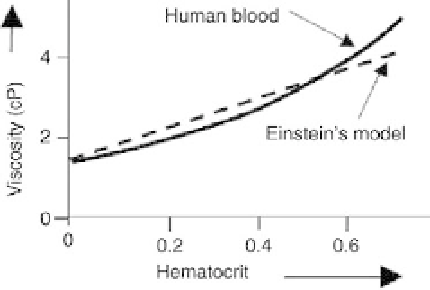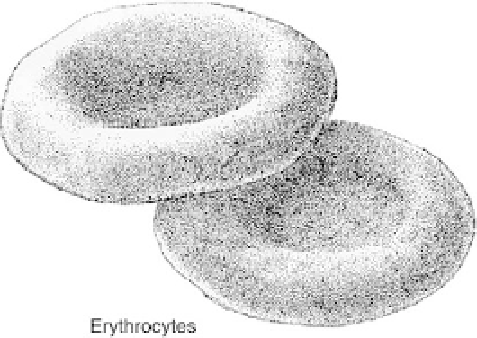Biomedical Engineering Reference
In-Depth Information
FIGURE 14.26
Blood viscosity as a function of blood hematocrit. Albert Einstein developed a model of viscosity
of a fluid with a large concentration of substances where c
>
10%.
The erythrocytes are the most numerous blood cells, about 4-6 millions/mm
3
. They are
also called red cells. In humans and all mammals, erythrocytes are devoid of a nucleus and
have the shape of a biconcave lens. The red cells are rich in hemoglobin, a protein able to
bind to oxygen. Hence, these cells are responsible for providing oxygen to tissues and
partly for recovering carbon dioxide produced as waste. However, most CO
2
is carried
by plasma in the form of soluble carbonates. Red cells, which are the most prolific cells in
the bloodstream, form the basis of the hematocrit, which is a factor in the determination
of blood viscosity. A typical red cell is shown in Figure 14.27. The other blood cells are
the leucocytes (white cells), which are designed to combat infections, and the thrombocytes
(platelets), which are designed to assist in the clotting process.
White blood cells are colorless without hemoglobin. They contain a nucleus and have an
irregular shape. Though there are fewer white blood cells than red blood cells, they are
much bigger in size. They can change their shape easily, and this allows them to squeeze
through the walls of the blood vessels into the intercellular spaces. Unlike red blood cells
or platelets, there are five different types of white blood cells, each serving a different pur-
pose in our body's immune system. Neutrophils make up 55 to 70 percent of the total white
FIGURE 14.27
Red cells consisting of biconcave disks, each 8 microns in diameter and 2 microns thick.



